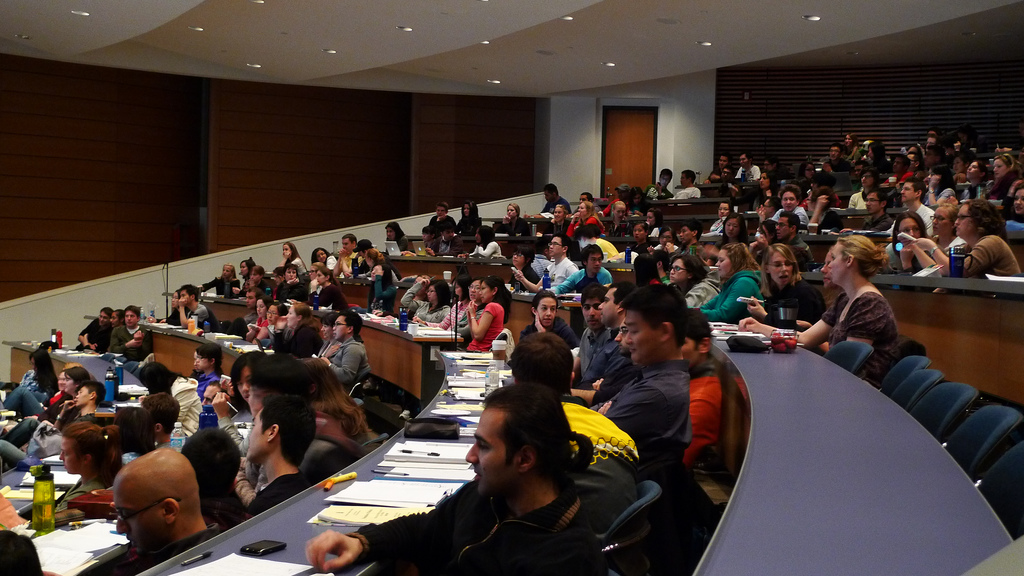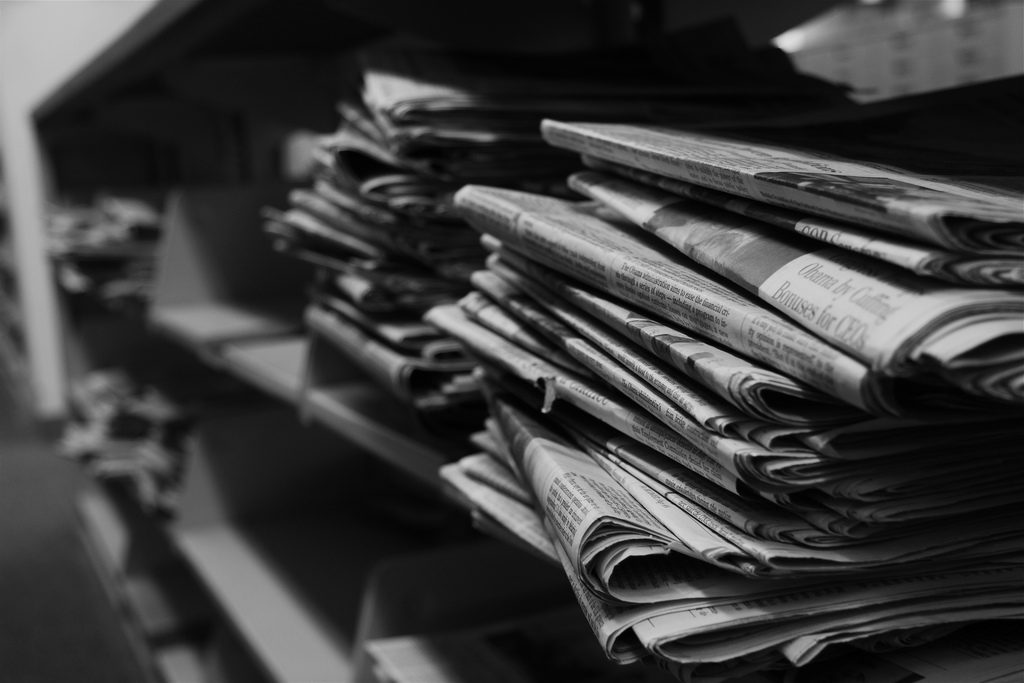The full News Literacy course, developed at Stony Brook University, organizes the material into 8 concepts that are spread amongst our 14 week course that take students from the first information revolution of Johannes Gutenberg's printing press to the Digital Age of Mark Zuckerberg's Facebook. Each lesson stands alone or can easily be integrated into your program.
Below, find a summary of each of those lessons, and a link to the most updated version of the teaching materials for each from our professors at Stony Brook University. Each of the following Course Packs include PowerPoint presentations, associated media, lecture notes, and recitation materials.
Updated Course Syllabus

.
Lesson 1: Why News Literacy Matters
 News Literacy Lesson 1 Course Pack - Updated SPRING 2018
News Literacy Lesson 1 Course Pack - Updated SPRING 2018
- In the wake of the latest information revolution, it is up to the consumer to determine whether information is reliable and whether to publish it.
.
Lesson 2: The Power of Information
 News Literacy Lesson 2 Course Pack - Updated SPRING 2018
News Literacy Lesson 2 Course Pack - Updated SPRING 2018
- Since humans first walked the earth, the power of information has derived from its ability to alert, divert and connect people.
- The power of print: Why Napoleon said: "Four hostile newspapers are more to be feared than a thousand bayonets."
- The power of images and video: They can move audiences and bring about change.
- The power of social media: How platforms like Twitter and Facebook spread and make news.
- Freedom of the press: How the First Amendment’s guarantees are based on the conviction that the excesses of a free press a price are a price worth paying for keeping our government and other institutions in check.
.
Lesson 3: Is it True? Part 1
 News Literacy Lesson 3 Course Pack - Updated SPRING 2018
News Literacy Lesson 3 Course Pack - Updated SPRING 2018
- Journalists and scientists have a similar understanding of truth — a statement of probability that’s proportional to the amount of available evidence and subject to an informal system of peer review.
- The concept of provisional truth: Because journalism is a snapshot in time, journalistic truth evolves as new evidence emerges. The lesson for news consumers: Follow a story over time.
- Context and transparency: Key concepts in the journey from fact to truth. Valuable news stories put information in context and are transparent about how reporters know what they know and don’t know and why.
- Truth is more likely to emerge when you look at a story from different perspectives. Journalists do that by trying to include the voices of all involved.
.
 Lesson 4: But is it true? Part 2: Verification
Lesson 4: But is it true? Part 2: Verification
 News Literacy Lesson 4 Course Pack - Updated SPRING 2018
News Literacy Lesson 4 Course Pack - Updated SPRING 2018
- Journalists pursue the truth by following a ranking of direct evidence that places the greatest value on photographs and videos, documents and records, personal observations and witnesses.
- Seeing isn't always believing. News outlets and consumers must also verify the authenticity of visual journalism. How news organizations and consumers evaluate still images and videos.
- Assessing the value of polls, surveys and studies. Understanding the science of polling and evaluating reports of scientific breakthroughs.
- The battle between journalism’s pursuit of the truth and digital-age business models: How the fight for page views, ratings and circulation can put journalistic values in peril.
.
Lesson 5: What Makes News Different?
 News Literacy Lesson 5 Course Pack - Updated SPRING 2018
News Literacy Lesson 5 Course Pack - Updated SPRING 2018
- News is information of some public interest that is shared and subject to a journalistic process of verification, and for which an independent individual or organization is directly accountable. Those three attributes are represented in the acronym VIA, and all must be present to classify information as journalism.
- Who is a journalist? Is “citizen journalism” really journalism? In a world where news consumers are also news producers, VIA becomes a litmus test.
- Know your neighborhood. One of the keys to determining if information is reliable is being able to identify what it is: journalism, advertising, publicity, propaganda, entertainment or raw information.
- The blurring of the lines between these information neighborhoods is one of the biggest challenges facing news consumers.
- Understanding why advertising, promotion and propaganda pose as journalism. The tactic isn't new, but economic pressures are fueling the rise of “native advertising.”
.
Lesson 6: Who Decides What's Newsworthy?
 News Literacy Lesson 6 Course Pack - Updated SPRING 2018
News Literacy Lesson 6 Course Pack - Updated SPRING 2018
- Historically, news outlets have determined news value through a combination of four factors: Universal news drivers, editorial judgment, an understanding of their target audience and the news outlet's business model.
- Universal News Drivers: Importance, Timeliness, Proximity, Magnitude, Prominence, Conflict, Human Interest, Change, Relevance, Unusualness.
- Great images and compelling video drive story play. They’re powerful tools for verification, but can distract or influence the perceptions of news consumers and skew news judgment.
- Increasingly, the audience determines newsworthiness. The rise of commenting, most-shared status, website algorithms and real-time analytics drive story selection and play online.
- As more and more people get their news through social media, news aggregating sites and apps, savvy consumers should identify news outlets they can trust and depend on to curate the news.
.
Lesson 7: Fairness and Balance - Part I (Is it Fair? Is it Biased?)
 News Literacy Lesson 7 Course Pack - Updated SPRING 2018
News Literacy Lesson 7 Course Pack - Updated SPRING 2018
- Responsible journalism aspires to being fair to all sides of a story and to the facts themselves. It requires fair presentation, language and treatment.
- The selection and layout of Images in print and on websites can have an impact on and videos on balance and fairness. Editing and production techniques can do the same in video reports.
- Defining bias: Bias is not an event -- it's a pattern of unfairness found in the coverage of a single news organization over time.
- Three ways to spot bias: 1) Look for a pattern over time in a single news outlet's coverage. 2) Compare coverage of the same stories by other outlets. 3) Take note of the self-interest of those alleging bias.
- Sometimes bias is institutional: Partisan news outlets operate on a business model rooted in taking sides and blurring the line between news and opinion.
- Sometimes the perception of bias is rooted not in journalistic bias but in audience bias. News consumers who seek affirmation, not information, distrust or dismiss information that disagrees with their opinions or beliefs because that causes cognitive dissonance.
- To avoid cognitive dissonance, news consumers seek out reports that confirm their opinions and beliefs and avoid that which does not.
Lesson 8: Fairness & Balance - Part II (When Journalists Take Sides)
 News Literacy Lesson 8 Course Pack - Updated SPRING 2018
News Literacy Lesson 8 Course Pack - Updated SPRING 2018
- Though true objectivity may not be attainable, the journalistic discipline of impartiality is a key to achieving fairness. When journalists take sides, they blur or cross the line between news and opinion.
- Beware of loaded language: The difference between description and characterization and what happens when news organizations adopt the language of partisans in a dispute.
- Distinguishing between legitimate opinion journalism and mere assertion. Moynihan's maxim: "Everyone is entitled to his own opinion, but not his own facts.
- .
Lesson 9: The Medium is the Message - Part 1
 News Literacy Lesson 9 Course Pack - Updated SPRING 2018
News Literacy Lesson 9 Course Pack - Updated SPRING 2018
- Newspapers and magazines still offer the most comprehensive coverage, but market forces, technological advances and demographic changes have dramatically reduced their resources and reach.
- Radio has survived by maintaining an intimacy and immediacy and developing its own style of storytelling.
- TV news is still the most powerful tool for following breaking news stories with compelling visuals, but it exists in an entertainment medium.
.
 Lesson 10: The Medium is the Message - Part 2, Digital Media
Lesson 10: The Medium is the Message - Part 2, Digital Media
 News Literacy Lesson 10 Course Pack - Updated SPRING 2018
News Literacy Lesson 10 Course Pack - Updated SPRING 2018
- News websites and search engines have broadened the reach of news consumers while presenting them with new challenges — information overload, questions of authenticity and confirmation bias — in their pursuit of reliable information. A key lesson: Ranking on search engines does not necessarily indicate the reliability of a website or piece of information found online.
- The explosion of social media and the evolution of the news consumer from observer to news producer have brought not only a powerful level of engagement but also the proliferation of misinformation. Plus: How social media has been used in modern election campaigns.
.
Lesson 11: Says Who?
 News Literacy Lesson 11 Course Pack - Updated SPRING 2018
News Literacy Lesson 11 Course Pack - Updated SPRING 2018
- The decontruction process uses News Literacy concepts to analyze and dispassionately judge a report's reliability.
- Summarize the main points: Do the headline and lead support them?
- How close does the reporter come to opening the freezer? Is the evidence direct or indirect?
- Evaluate the reliability of the sources using IMVAIN.
- Is the reporter's work transparent? Does the reader learn what the reporter knows and does not know?
- Does the reporter place the story in context, providing facts that surround an event or elements of a news story and provide meaning or significance?
- Are the key questions answered? Who? What? When? Where? Why? How?
- Is the story fair?
.
Lesson 12: Deconstructing The News
 News Literacy Lesson 12 Course Pack - Updated SPRING 2018
News Literacy Lesson 12 Course Pack - Updated SPRING 2018
- This 7-step deconstruction process uses News Literacy concepts to analyze and dispassionately judge a report's reliability.
1. Summarize the main points and then check if the headline and the lead support the main point(s) of the story?
2. How close does the reporter come to opening the freezer? Is the evidence direct or “arm’s-length?”
3. Evaluate the reliability of the sources using IMVAIN.
4. Does the reporter make his or her work transparent?
5. Does the reporter place the story in context?
6. Are the key questions answered?
7. Is the story fair?
- Students apply the principles of deconstruction to all forms of traditional media including video and audio news stories.
- For video news, we analyze a series of “winners” and “sinners” and how you can tell the difference.
.
Lesson 13: Deconstructing New Media
 News Literacy Lesson 13 Course Pack - Updated SPRING 2018
News Literacy Lesson 13 Course Pack - Updated SPRING 2018
- Students learn to recognize the power and gauge the reliability of social media posts and websites
- A key lesson: Ranking on search engines does not necessarily indicate the reliability of a website or piece of information found online.
- The advent of crowdsourcing and "citizen journalists" has created new opportunities and challenges for both news outlets and news consumers.
